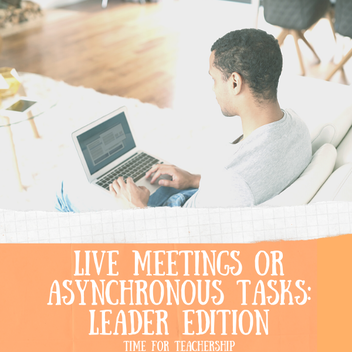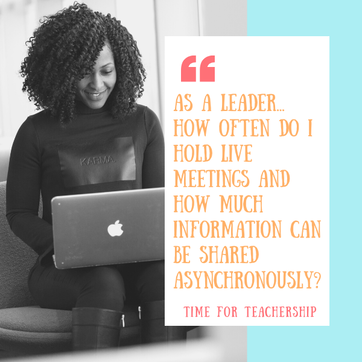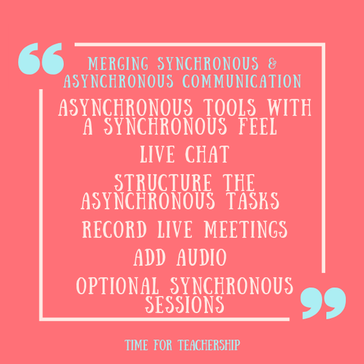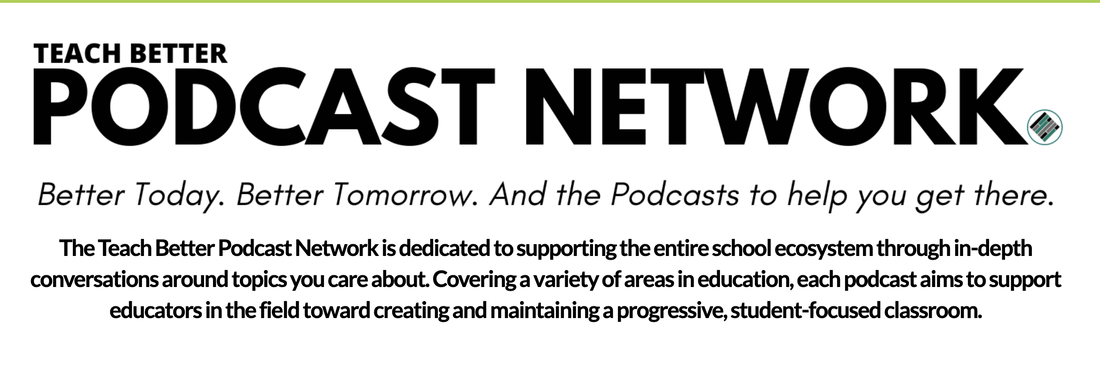|
The immediate priority was to figure out how students would engage in learning. Now that we’re a couple months into distance learning, you and your teachers likely have a better handle on that question, but another issue has emerged: Zoom fatigue (or Google Meet fatigue). At this point, students, teachers, and leaders are a bit worn out by constant video conferencing. While in some states, schools are wrapping up the year at the end of the month, other school districts, still have a month of school to go! Which presents a new question for leaders, similar to the one we’ve been helping teachers answer: How often do I hold live meetings and how much information can be shared asynchronously? Leaders have been supporting teachers as teachers have been supporting students, so let’s consider some of the same concepts we apply to an online class. Below, I’ll re-share some suggestions I shared with teachers, but with a focus on staff communication. Asynchronous tools with a synchronous feel. To maintain that sense of staff camaraderie, invite teachers who want to check in to post a video on Flipgrid. Help teacher teams set up group Voxer channels (or if your school is small, set up one Voxer channel for the whole staff). This way, you can hear and respond to colleagues’ voices without the possibly overwhelming visual stimuli or the need to be “on” at a particular time—you respond when you can. Use a live chat. You may have office hours in the same way teachers have tutoring or conferencing with students, but you can also address staff questions through chat-based tech tools. You could set up a staff page on your Learning Management System (e.g., Google Classroom, Schoology, Canvas). Post a question and be ready to respond in real time for a predetermined time span (e.g., 30 minutes). If teachers have questions about a particular document, have them add comments to the doc so you can respond. (You can do this immediately by scheduling time to be in the doc. Or, you can have teachers tag you by typing “+” or “@” followed by your email address in the comment. This way, you can respond when you have time, and the teacher will be notified of your response via email). Structure the asynchronous tasks. The same Define-Explore-Build framework I suggest for asynchronous classes, I use for teacher meetings as well. That might be: read the announcements, explore 1 distance learning article or tech tool tutorial from a list, and share out (i.e., what you learned, a question you have) on Flipgrid, in a discussion board, or in a shared doc/slide deck. As with students, keep the format the same. This is actually a great way to model for teachers what they can do with students, so be strategic here. To further support teachers with structure, you may want to offer a model of a sample educator schedule for working at home. Modeling scheduled breaks and how to set up your day for maximum efficiency could be helpful. (For example, I generally try to use mornings to create and afternoons for meetings or more menial tasks. Knowing this is the most efficient use of my energy, I try to avoid scheduling meetings in the mornings. I also need a brain break after the creativity-intensive mornings, so I try to use a walk outside as a way to reset before the afternoon tasks and meetings.) Model purposeful scheduling and boundary setting for your staff! Record live meetings. If you do have live meetings that are not super interactive, make them optional! Share the recording after you end the meeting. People can still get the information, see familiar faces, and have the option to watch it on 1.5x speed to save time. Add audio to asynchronous tasks. Record your meeting updates or staff memos using a screen sharing app like Screencastify or Screencast O'Matic. This way, you can explain something that may be confusing in writing. You could also annotate a website using InsertLearning (also modeling how teachers could do this with students). You could use the Talk & Comment Chrome extension to add a voice note in any conversation on any platform where you can add text. This also saves you time typing everything out! Optional synchronous sessions. Your live meetings could be purely social gatherings. So, extroverts who want that connection can attend and introverts who are meetinged-out don’t have to worry about missing important information. On this 12-minute Bossed Up podcast episode, Emilie Aries shares 10 tips for reducing Zoom fatigue. I addressed many of Emilie’s leader-based tips above, but there are a bunch of suggestions that staff members could benefit from hearing as well. Give it a listen, and if it feels helpful, share the episode with your team! As a preview, here are just two of Emilie’s tips and my thoughts on how they apply to leaders:
Finally, to support your staff with this last piece, direct them to my last blog post so they can read some working from home scheduling tips and get the free template and sample schedule. That’s a wrap on the tips for today. Go forth, and defeat Zoom fatigue, fearless leaders!
0 Comments
Leave a Reply. |
Details
For transcripts of episodes (and the option to search for terms in transcripts), click here!
Time for Teachership is now a proud member of the...AuthorLindsay Lyons (she/her) is an educational justice coach who works with teachers and school leaders to inspire educational innovation for racial and gender justice, design curricula grounded in student voice, and build capacity for shared leadership. Lindsay taught in NYC public schools, holds a PhD in Leadership and Change, and is the founder of the educational blog and podcast, Time for Teachership. Archives
May 2024
Categories |





 RSS Feed
RSS Feed